 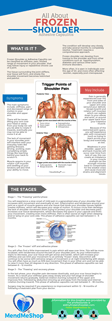
| An Overview of Shoulder ManipulationShoulder Manipulation is Also Known As Shoulder manipulation can be the right choice for you. Like surgery, it is generally considered when other options have failed. If you are unsure about whether you need shoulder manipulation, go to this page: The State of a Shoulder Where Manipulation Is ConsideredYour shoulder by design is a joint that has the capacity to move the arm in a wide range of motion across multiple planes and bear very significant loads while doing so. Any joint that has these attributes must by design be fairly complex. The name of the shoulder joint is known as the Glenohumeral Joint. 
At the very top of the arm bone (humerus), there is a "ball"-like end on it. This "ball" fits into a shallow socket known as the Glenoid Cavity (or Glenoid Fossa) that is located at the end of the shoulder blade (scapula). Picture a a loose, elastic shell that surrounds the whole joint, all the way around the socket - this is known as the Joint Capsule. Stabilizing the humerus to your core are numerous ligaments and tendons both inside and outside of this capsule. A shoulder that is considered for manipulation is a shoulder with a joint capsule that is inflamed and/or tight - usually the shoulder is a Frozen Shoulder, and can happen without apparent cause. Sometimes, this can happen after shoulder surgery, after an accident or as a condition brought on from diabetes. There are some shoulder cases where the capsule is very tight but there is little, if any, inflammation. Such cases typically occur from a major shoulder injury they have had in the past that has become chronic. This is basically termed as "Post Traumatic Stiffness". The Joint Capsules of such shoulders have little swelling but also very little movement or Range of Motion (ROM) due to a large amount of scar tissue in the capsule and surrounding tendons, ligaments and muscles.
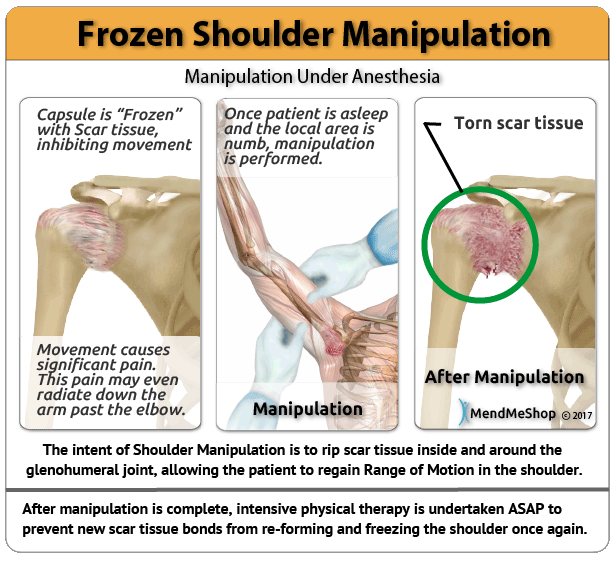 Cases Where Odds of a Successful Manipulation Result Is LowSuch cases are as follows*:
*"Manipulation Under Anaesthesia | Shoulderdoc". Shoulderdoc.co.uk. N. p., 2017. Web. 19 June 2017. If You Haven't Done So Yet, Get a Proper DiagnosisShoulder manipulation is not effective unless you really do have frozen shoulder. This is why it is important to get to a physician and find out what is really going on - this is known as getting a proper diagnosis. Getting a proper diagnosis would also determine if your locked shoulder is referred pain or a side effect from another condition or disease (diabetes or lyme disease are two examples). This is less common but nonetheless, very serious. So yes, it is important to get a proper diagnosis - and even more important when pertaining to frozen shoulder. About Shoulder Manipulation Under AnaesthesiaThe Goal of Shoulder ManipulationThe goal of a Shoulder Manipulation is to increase the Range of Motion (ROM) of the shoulder joint. During a manipulation, the Joint Capsule will be torn by forceful stretching of the arm while you are sleeping (under an anaesthetic). A Shoulder Manipulation may involve arthroscopic surgery (aka keyhole surgery) where 2 or 3 small incisions are made in the shoulder to insert an arthroscope and specialized releasing tools to reach the joint capsule location. The scar tissue and tight capsule will be "released" (cut and or torn) resulting in a much improved range of motion. A good description of the process is quoted as follows: How a Shoulder Manipulation Is Done (Technique)...The surgeon should stand at the head end of the table with one hand stabilizing the scapula in the resting position. The surgeon's other hand should then be placed in the patient's axilla such that the surgeon's forearm is resting against the whole of the inside of the patient's arm. First, abduction is taken to the patient's free limit, and then the patient is forcibly abducted while the scapula is maintained down in the anatomic position. The scapula must not move at any stage. This maneuver will rupture the inferior capsule. The shoulder is then forcibly adducted such that the affected elbow is pushed in front of the patient's chin to rupture the posterior capsule. Finally, forcible external rotation and internal rotation are added, but great care is taken here because it is during these final rotation maneuvers that a spiral fracture can be caused. Risks of a Shoulder Manipulation OperationThere is always some risk during an operation, though continuous improvement and refinement of surgeries are always focused on minimizing risk as much as possible. The risks of shoulder manipulation surgery generally relate to:
A shoulder manipulation should be considered with much the same gravity as surgery. As such, all risks, issues and concerns should be discussed with your physician before undergoing a shoulder manipulation. **Source: "Manipulation Under anaesthetic (MUA) and athroscopic capsular release (ACR)| Royal Berkshire, NHS Foundation Trust ". http://www.royalberkshire.nhs.uk, 2017. Web. 28 June 2017. Is The Shoulder Manipulation Procedure Painful?Yes, it is but you will be asleep and have a local anaesthetic injected in the shoulder to help reduce pain. The anaesthesiologist may numb your whole arm for a few hours after the operation in cases of sharp pain. You will probably be prescribed painkillers, and be ready to take the tablets as directed (probably when the pain levels start to get high). After A Shoulder ManipulationIt is known by doctors and physical therapists that manipulation will increase shoulder Range of Motion (ROM) by ripping soft tissue at the cost of introducing more scar tissue into the shoulder. This added scar tissue can be very problematic, requiring quite a bit of PT and often significant treatment post-manipulation. If not dealt with properly, your shoulder could end up in worse condition than before. This is why manipulation is only performed as a last resort. When considering whether or not to manipulate your shoulder, physicians carefully weigh the risks and pros and cons. Part of the consideration may very well be whether or not they think you will undergo the intensive PT that is very important for successful recovery. Post-Operative Management & Common QuestionsPhase 1: Getting Past Post-Operative Shoulder Manipulation PainYou will probably suffer from an increase in pain for the first few weeks; this will probably affect your ability to do everyday activities - especially if the manipulation was done on the shoulder of your dominant hand. So be prepared for this, and have some help available for you after the operation. Phase 2: Regaining Movement After Shoulder ManipulationPain after shoulder manipulation will be significant but should gradually decrease over time. With the decreasing levels of pain, you should be able to stretch and exercise more frequently and for a longer duration, which is VERY IMPORTANT. Normally the change in movement will occur withing 4 to 6 weeks after the manipulation is done. You will find certain movements get better more quickly than others - this is common. Getting the hand up behind the back is usually the last and most difficult movement to regain after manipulation. Regaining perfect range of motion is unlikely, but you might find that even small gains in ROM will improve your ability to do everyday activities. Those suffering from diabetes have a reduced chance of an optimal outcome. When Can I Drive or Return to Work?Generally speaking, most clients can start driving about 2 or 3 weeks after a manipulation. Before considering getting behind a wheel, ensure that you can manage all the controls and use the seat belt properly (attach/detach). The seat belt will probably be uncomfortable for a while, but it shouldn't cause harm to the shoulder. It is also best to start driving for short journeys only. Regarding a return to work, the time of return will depend a lot on the type of work you do. For desk jobs, you can probably return in a couple weeks. For jobs that involve heavy lifting or other manual work, it will probably be a month before you can return. Be sure to discuss this with your physician or physiotherapist for a go-ahead. When Can I Get Back to My Leisure Activities?Activities such as gardening, hiking etc are really dependent on the range of motion you currently have. Nothing is ruled out but a general rule to follow is to consult with your physiotherapist first. Low impact water activities are often considered a good idea to start with as long as you start out slowly. When walking, try to regain the natural swing of the arms as it will help improve your ROM without overstressing it. Do I Need To Wear a Sling After the Manipulation? It is common to return from your manipulation surgery wearing a sling but it is important to know that the sling is really just there for your comfort (pain management). Pain will be present when you start your recovery and in many cases, the sling is really needed just to help reduce the pain for a while. Knowing that the whole purpose of a manipulation is to increase ROM, it is really a bad idea to keep the sling on all the time - the goal is for you to increase movement in your arm so do not keep your arm in the sling for a long duration of time without doing your exercises. Once you feel able, stop using the sling. I Can't Sleep Due to the Pain - What Do You Recommend?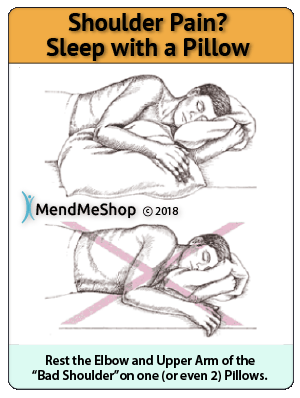 If your sleep position is on the side with your weight on your "good" shoulder (the one that WASN'T manipulated), put one or even two pillows in front of you and rest the elbow and upper arm of your "bad" shoulder (the one that WAS manipulated) on these pillows. This should help keep your shoulder pain level down so you can get to sleep. If your sleep position is on your back, it is recommended to try putting a thin pillow or rolled up towel under your "bad" arm. If it doesn't do the trick you might find sleeping on your side with the pillow supports is the better option to at least help you sleep. Natural steroid levels in the body are reduced at night which helps explain why some swelling induced pain and annoying issues such as throbbing arise once you go to bed. Furthermore, your body is now horizontal which alters blood pressure in the shoulder and arms - such seemingly minor changes can have a big impact on your ability to sleep. In some cases, anti-inflammatories are prescribed though we always recommend trying cold compression if you find you can't sleep due to throbbing or an increase in pain in the shoulder. What Do I Do About Surgical Wounds?If you didn't undergo arthroscopy, there won't be any wounds. If you have had arthroscopy, you will have dressings over the wounds, though there are likly no stitches as the wounds are almost always quite small. Keep the wounds dry until healed, typically 5 to 7 days. Exercise, StretchingOnce your shoulder manipulation is done, you will realize very quickly that it is very important to undergo an intensive PT regimen as not doing so will greatly increase the chance that your shoulder will freeze up again.
The exercises you are told to do are designed to try and maintain any increased ROM that you gained via the manipulation. You will be under strict order to exercise and stretch both at the clinic and at home, straight away! You will need to get into a habit of consistent, frequent exercises at home, multiple times per day for several months. As you progress, exercise goals will be changed.
How To Greatly Increase Your Chance of a Successful Outcome After Shoulder ManipulationOk, well the good news is that AidMyFrozenShoulder conservative treatments tools are highly effective for helping recover from shoulder manipulation. To Increase Your Chance of a Successful Shoulder Manipulation:
The TShellz Wrap® is a registered medical device. These is an effective conservative treatment wrap that can be used at home in conjunction with your PT. Even when your PT is over, you can use the TShellz Wrap® to continue your recovery treatments if you feel your recovery is incomplete. When to use a Cold Compress or Ice Pack:
When to use a Shoulder TShellz Wrap:
Restricted Movement Is Risky If It Goes On For Too Long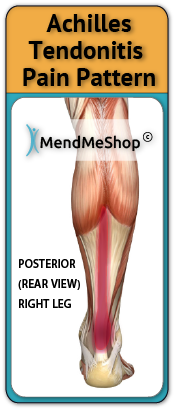 For acute (new or recent) Achilles tendon tears that have the ability to heal on their own - your doctor may even cast your foot in a toe pointed position (in something called a "hanging enquinus cast") or in a removable brace/splint. A removable splint can be very helpful to prepare you for PT sessions and mobility exercises. Prolonged use of a cast, removable splint, or long-term rest (restricted movement) without proper exercise or stretching can make your Achilles tendon injury worse. If your Achilles tendon remains completely immobilized and at constant rest, the ends of the Achilles tendon (where it attaches to bone or other muscles) will begin to fill in with scar tissue as part of the healing process. You may also have on-going symptoms of pain, swelling and inflammation, and even poor blood flow circulation. Lack of proper blood flow and growth of scar tissue will decrease the natural length of the tendon (atrophy) and tighten tissue, reducing the flexibility between your ankle and foot. Your ability to push off with your foot in certain activities such as running, jumping, or going up and down stairs all become compromised. You are also at an increased risk of re-rupture of the tendon, especially if the initial injury was large and required surgery in the first place. The Next Step Is Up To You! Living with pain is never easy as it affects your entire lifestyle. Living with pain after an intensive manipulation is not easy either. After a manipulation we highly recommend treating yourself at home with our Shoulder TShellz Wraps before stretching to increase elasticity and reduce the chance of over-straining. Furthermore, the circulatory system boost gained by daily Circulatory Boost treatments is intended to maximize your body's ability to recover, allowing you to get back to an active lifestyle in a shorter time period. Doctors and Surgeons are always improving the technologies used in manipulations, but keep in mind that manipulations introduce scar tissue, and recovery can be often disappointing - especially if you do not adhere to a strict and lengthy PT routine. If you do wind up getting manipulation, know that rehabilitation at-home while attending regular PT or doctor appointments is vital for your overall recovery. It is especially vital to the shoulder areas, as they consistently handle extreme forces (body weight). Consistent exercise and conservative treatment on a daily basis during your rehabilitation while working with your doctor, surgeon or physical therapist is key - and this is why you should seriously consider maximizing your recovery by using the TShellz Wrap at home. AidMyFrozenShoulder.comstands out in this regard as our goal is to help you keep your shoulder healthy for the long-term in a cost effective manner. This might mean minimizing your downtime so you can get back to a productive lifestyle more quickly. We strongly believe that we can help you, and we have thousands of happy clients to back this claim. You are welcome to try our products for a 60 day period.. If you are committed to following the treatments outlined in the product instructions we are very confident you will achieve benefits from our TShellz Wraps and accessory products. If you do not receive the benefits that countless of our other customers have experienced, call us, mail the product back to us and we will provide you with a full product refund. Our online shop accepts Visa & Mastercard as well as a Paypal Payment option. Living with pain is never easy and we encourage you to call us with any questions you have related to your frozen shoulder. We will do our best to help. Product Advisors are available 9:00 am to 5:00 pm Eastern Standard Time Monday to Friday. Learn More About Shoulder Injuries & TreatmentsI want to learn more about Frozen Shoulder Causes. I want to learn more about TShellz Wrap® Circulatory Boost I want to learn more about Ice & Heat: Which Is Better For Treatment? I want to learn more about Trigger Points. I want to learn more about Frozen Shoulder Manipulation. I want to learn more about Post Surgery Recovery? FREE SHIPPING ON ALL PRODUCTS CURRENTLY ENABLED |
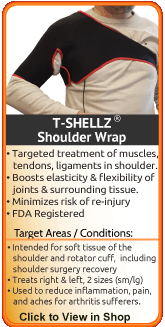 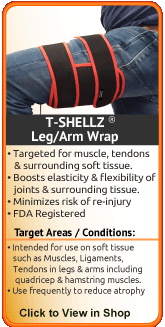  |
